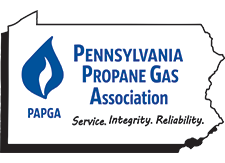For more information, contact:
Shelby L. Metzger
717.441.6040
Shelby@papropane.com
Harrisburg, PA – The supply of propane across the United States is strong. Recent supply data reveals that in 2013 propane production in the United States increased by nearly 1 billion gallons. During the five year period from 2008 through 2013, U.S. propane production increased by 2.6 billion gallons.
In the late fall of 2013 a number of separate events occurred that, when combined, exacerbated the effects of the transportation and infrastructure problems in the propane distribution network.
First, an unusually wet harvesting season and a bumper corn crop in the mid-west meant farmers were requesting significantly more propane for crop drying than they normally use during the harvest season.
Second, pipeline maintenance and changing pipeline flow patterns are a factor. The Cochin pipeline, which traverses North Dakota, Minnesota, Iowa, Illinois, Indiana, Michigan, and Ohio and operates 5 propane terminals in the U.S., was closed for maintenance most of December. The pipeline reopened on December 20.
Third, there is reduced capacity for propane transports via rail. Due to the growth in the availability of shale energy, and the lack of pipeline infrastructure in the areas that contain this energy, rail cars that would normally carry propane have been repurposed to carry raw NGLs from the Bakken shale formation before being fractionated in to propane, ethane, etc. This means that a primary mode of transporting propane around the country now has reduced capacity.
Finally, proposals to build primary storage facilities are collecting dust on the desks of government officials across the U.S. For example, one application for a critical storage facility for New York and New England has been awaiting approval from members Governor Cuomo’s cabinet since 2009. The Finger Lakes LPG Storage Facility would house 88.2 million gallons of propane and connect to the existing TEPPCO interstate pipeline and ship propane via truck and railcar.
The current proposal calls for a rail/truck loading facility that is capable of being operated on a 24hour basis 365 days a year. To highlight the importance of this storage facility, New England accounts for 7% of national total consumer propane demand, but holds only 1.2% of total primary propane storage capacity. Independent analysis estimates average heating season consumption in New England at just under 3 million gallons per day.
In conclusion, the propane supply in the United States remains the strongest it has been in recent memory. What Pennsylvania customers are feeling are the results of a strained transportation and infrastructure system that are masquerading as a propane shortage.
The Pennsylvania Propane Gas Association is a member-focused trade association providing services that communicate, educate and promote the propane industry in Pennsylvania. The association was formed in 1947 to offer opportunities to learn through training and networking with peers, and to aid with legislative issues that contribute to operating a safe and successful industry.
Click Here to Follow Us on Facebook
Click Here to Follow Us on Twitter
Click Here to download our Mobile APP
Attachments
Statement On Propane Transportation And Infrastructure Issues

 Mower Equipment
Mower Equipment